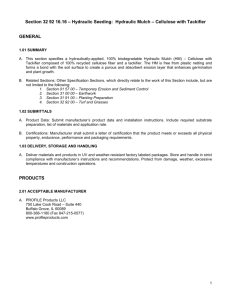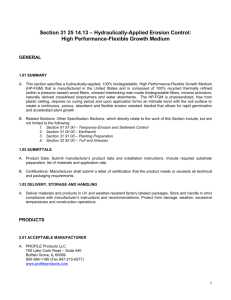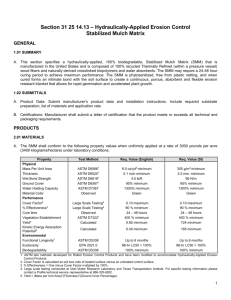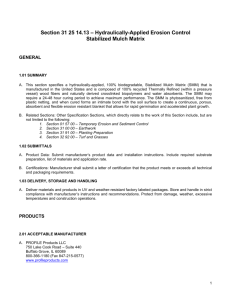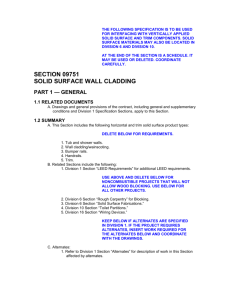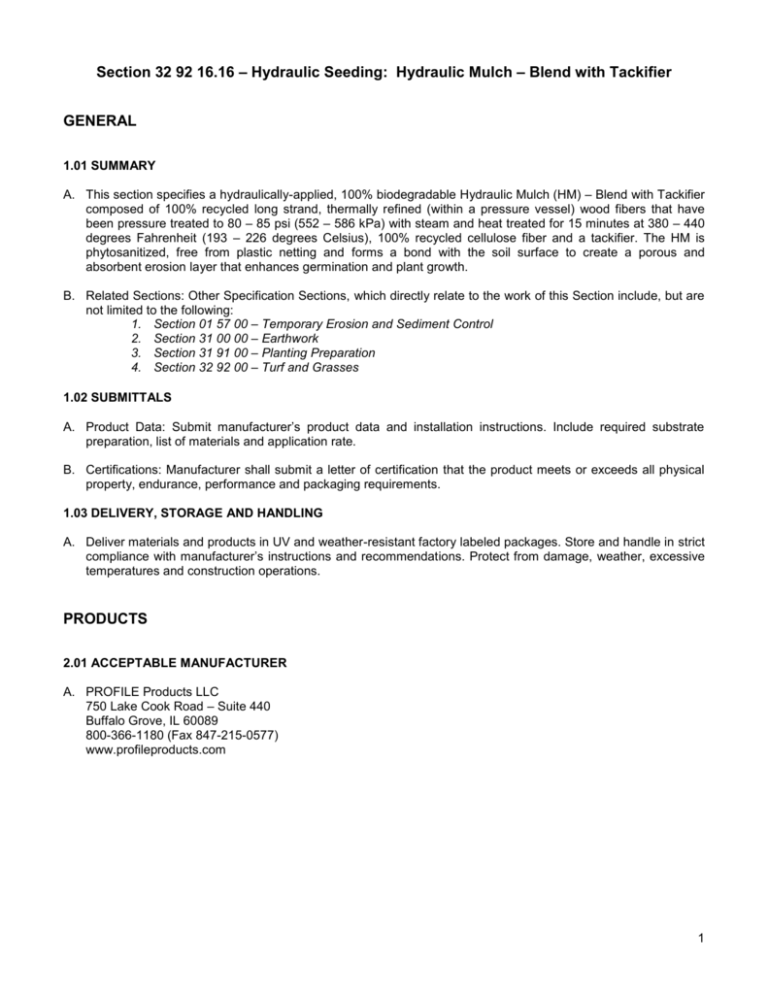
Section 32 92 16.16 – Hydraulic Seeding: Hydraulic Mulch – Blend with Tackifier
GENERAL
1.01 SUMMARY
A. This section specifies a hydraulically-applied, 100% biodegradable Hydraulic Mulch (HM) – Blend with Tackifier
composed of 100% recycled long strand, thermally refined (within a pressure vessel) wood fibers that have
been pressure treated to 80 – 85 psi (552 – 586 kPa) with steam and heat treated for 15 minutes at 380 – 440
degrees Fahrenheit (193 – 226 degrees Celsius), 100% recycled cellulose fiber and a tackifier. The HM is
phytosanitized, free from plastic netting and forms a bond with the soil surface to create a porous and
absorbent erosion layer that enhances germination and plant growth.
B. Related Sections: Other Specification Sections, which directly relate to the work of this Section include, but are
not limited to the following:
1. Section 01 57 00 – Temporary Erosion and Sediment Control
2. Section 31 00 00 – Earthwork
3. Section 31 91 00 – Planting Preparation
4. Section 32 92 00 – Turf and Grasses
1.02 SUBMITTALS
A. Product Data: Submit manufacturer’s product data and installation instructions. Include required substrate
preparation, list of materials and application rate.
B. Certifications: Manufacturer shall submit a letter of certification that the product meets or exceeds all physical
property, endurance, performance and packaging requirements.
1.03 DELIVERY, STORAGE AND HANDLING
A. Deliver materials and products in UV and weather-resistant factory labeled packages. Store and handle in strict
compliance with manufacturer’s instructions and recommendations. Protect from damage, weather, excessive
temperatures and construction operations.
PRODUCTS
2.01 ACCEPTABLE MANUFACTURER
A. PROFILE Products LLC
750 Lake Cook Road – Suite 440
Buffalo Grove, IL 60089
800-366-1180 (Fax 847-215-0577)
www.profileproducts.com
1
2.02 MATERIALS
A. The Hydraulic Mulch – Blend with Terra-Blend™ with Tacking Agent 3® and conform to the following property
values.
Property
Physical
Water Holding Capacity
Color
Performance
Cover Factor1
% Effectiveness2
Environmental
Functional Longevity4
Ecotoxicity
Biodegradability
Test Method
Req. Value (English)
Req. Value (SI)
ASTM D7367
Observed
1000% minimum
Green
1000% minimum
Green
Large Scale Testing3
Large Scale Testing3
0.60 maximum
40% minimum
0.60 maximum
40% minimum
ASTM D5338
EPA 2021.0
ASTM D5338
Up to 3 months
96-hr LC50 > 100%
100% minimum
Up to 3 months
96-hr LC50 > 100%
100% minimum
1. Cover Factor is calculated as soil loss ratio of treated surface versus an untreated control surface.
2. % Effectiveness = One minus Cover Factor multiplied by 100%.
3. Large scale testing conducted at Utah Water Research Laboratory. For specific testing information please contact a Profile technical
service representative at 866-325-6262
4. Functional Longevity is the estimated time period, based upon ASTM D5338 testing and field observations, that a material can be
anticipated to provide erosion control and agronomic benefits as influenced by composition, as well as site-specific conditions, including;
but not limited to – temperature, moisture, light conditions, soils, biological activity, vegetative establishment and other environmental
factors.
2.03 COMPOSITION
A. All components of the HM shall be pre-packaged by the Manufacturer to assure both material performance and
compliance with the following values. No chemical additives with the exception of fertilizer, liming and
biostimulant materials should be added to this product.
1. Thermally Processed (within a pressure vessel) Wood Fiber (minimum) – 70%
a) Heated to a temperature greater than 380 degrees Fahrenheit (193 degrees Celsius) for
15 minutes at a pressure greater than 80 psi (552 kPa)
Cellulose Fiber (maximum) – 27%
Polymer Based Tackifier – 3% + 1%
2.04 PACKAGING
A. Bags: Net Weight – 50 lb, UV and weather-resistant plastic film
Pallets: Weather-proof, stretch-wrapped with UV resistant pallet cover
Pallet Quantity: 40 bags/pallet or 1 ton/pallet
EXECUTION
3.01 SUBSTRATE AND SEEDBED PREPARATION
A. Examine substrates and conditions where materials will be applied. Apply product to geotechnically stable
slopes that have been designed and constructed to divert runoff away from the face of the slope. Do not
proceed with installation until satisfactory conditions are established.
B. Depending upon project sequencing and intended application, prepare seedbed in compliance with other
specifications under Section 1.01 B
3.02 INSTALLATION
A. Strictly comply with equipment manufacturer's installation instructions and recommendations. Use approved
hydro-spraying machines with fan-type nozzle (50-degree tip). To achieve optimum soil surface coverage,
2
apply HM from opposing directions to soil surface. Rough surfaces (rocky terrain, cat tracks and ripped soils)
may require higher application rates to achieve 75% cover. Slope interruption devices or water diversion
techniques are recommended when slope lengths exceed 25 feet (8 m). Maximum slope length is for product
applications on a 4H:1V slope. For application on steeper slopes, slope interruption lengths may need to be
decreased based on actual site conditions. Not recommended for channels or areas with concentrated water
flow. No chemical additives with the exception of fertilizer, liming and biostimulant materials should be added
to this product.
B. For Erosion Control and Revegetation: To ensure proper application rates, measure and stake area.
1. Apply fertilizer with specified prescriptive agronomic formulations, seed and HM at a rate of 50 lb
per 100 gallons (23 kg / 380 liters) of water over properly prepared surfaces. Confirm loading rates
with equipment manufacturer.
Do not apply on saturated soils or substrates. Do not apply if precipitation is anticipated within 24-48 hours.
C. Mixing: A mechanically agitated hydraulic-application machine is recommended:
1. Fill 1/3 of mechanically agitated hydroseeder with water. Turn pump on for 15 seconds and purge
and pre-wet lines. Turn pump off.
2. Turn agitator on and load low density materials first (i.e. seed).
3. Continue slowly filling tank with water while loading fiber matrix into tank.
4. Consult application and loading charts to determine number of bags to be added for desired area
and application rate. Mix at a rate of 50 lb of HM per 100 gallons (23 kg/380 liters). Contact
Equipment manufacturer to confirm optimum mixing rates.
5. All HM should be completely loaded before water level reaches 75% of the top of tank.
6. Top off with water and mix until all fiber is fully broken apart and hydrated (minimum of 10 minutes
— increase mixing time when applying in cold conditions). This is very important to fully activate
the bonding additives and to obtain proper viscosity.
7. Add fertilizer
8. Shut off recirculation valve to minimize potential for air entrainment within the slurry.
9. Slow down agitator and start applying with a 50-degree fan tip nozzle.
10. Spray in opposing directions for maximum soil coverage.
D. Application Rates: These application rates are for standard conditions. Designers may need to increase
application rates on rough surfaces. Consult application and loading charts to determine number of bags to be
added for desired area and application rate.
Slope Gradient / Condition
English
SI
< 4H to 1V
> 4H to 1V and < 3H to 1V
2000 lb/ac
2500 lb/ac
2250 kg/ha
2800 kg/ha
3.03 CLEANING AND PROTECTION
A. After application, thoroughly flush the tank, pumps and hoses to remove all material. Wash all material from the
exterior of the machine and remove any slurry spills.
B. Clean spills promptly. Advise owner of methods for protection of treated areas. Do not allow treated areas to be
trafficked or subjected to grazing.
D ENGLISH SI
© 2010 PROFILE Products LLC. All Rights Reserved. A copyright license to reproduce this specification is hereby granted to nonmanufacturing landscape architects, specification writers and designers. December 2010.
3

